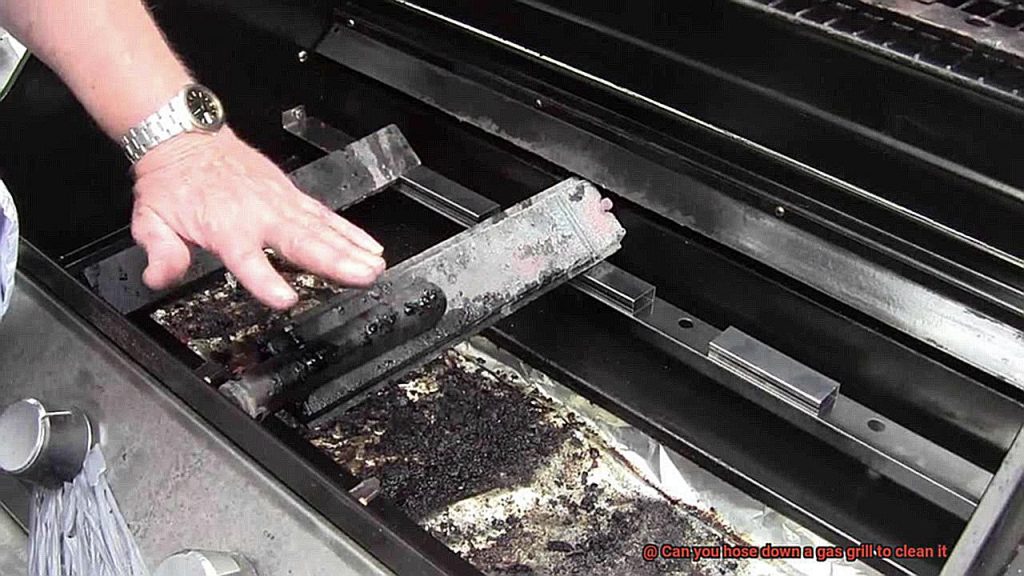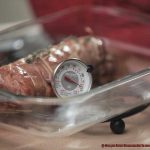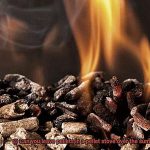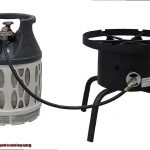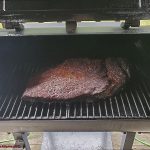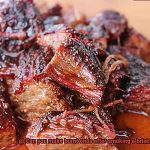The tantalizing smell of sizzling steaks and perfectly charred veggies fills the air, making our taste buds dance with anticipation. But hold on a minute, before you unleash your gas grill for another epic cookout, let’s talk about the importance of giving it a good cleaning.
Now, there are plenty of ways to keep your grill in tip-top shape, but one burning question remains: can you hose down a gas grill to clean it? Well my fellow grilling enthusiasts, I’m here to tell you that yes, hosing down your gas grill can be an absolute game-changer when it comes to keeping it sparkling clean.
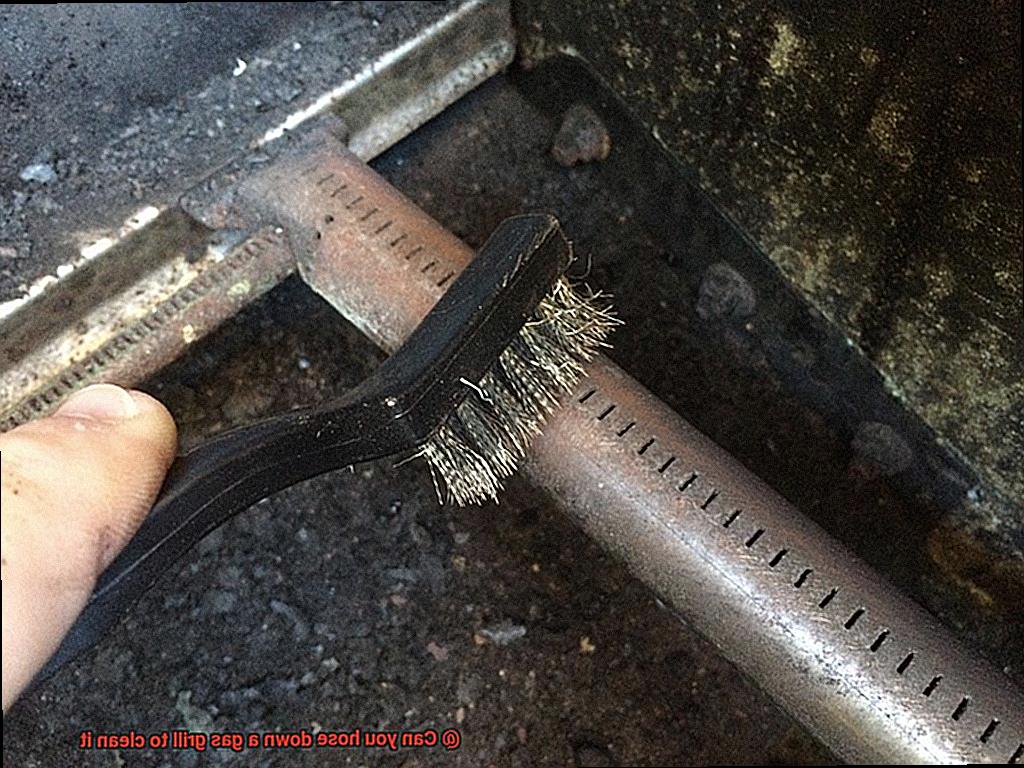
In this blog post, we’re going to dive deep into the nitty-gritty details of this method. We’ll cover all the dos and don’ts so that your grill stays in pristine condition throughout the entire summer season.
So, grab your trusty apron and let’s get started on this cleaning adventure.
Contents
Types of Gas Grills and Their Cleaning Requirements
Gas grills come in a variety of types to suit different needs. The most common type is the freestanding grill, which is perfect for backyard grilling. These grills have a sturdy base and wheels for easy mobility. Built-in grills, on the other hand, are designed to be permanently installed in outdoor kitchens or grill islands, offering a seamless and integrated look. Portable grills are compact and lightweight, making them great for camping, tailgating, or picnics. They usually run on small propane tanks. Lastly, tabletop grills are small and can be placed on a table or any flat surface. They are perfect for small spaces like balconies or apartment patios.
Regardless of the type of gas grill, there are some general cleaning tips that apply to all. Before cleaning any gas grill, it is important to turn off the gas supply and disconnect the propane tank or natural gas line. The first step in cleaning a gas grill is to remove the cooking grates and clean them thoroughly. This can be done by brushing off any food residue with a grill brush and then washing the grates with warm soapy water.
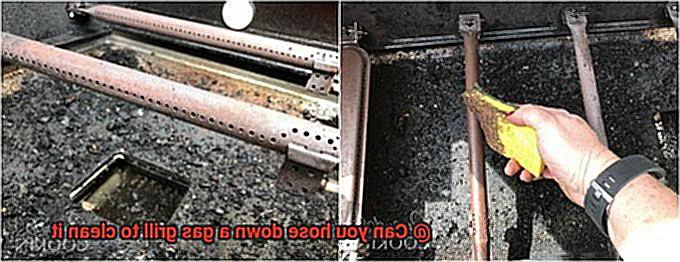
The burners should also be cleaned regularly to ensure proper functioning. Use a wire brush to remove any debris or grease buildup from the burner tubes. The flame tamers or heat deflectors, which are located above the burners, should be cleaned as well. They can be removed and washed with warm soapy water or brushed clean with a grill brush.
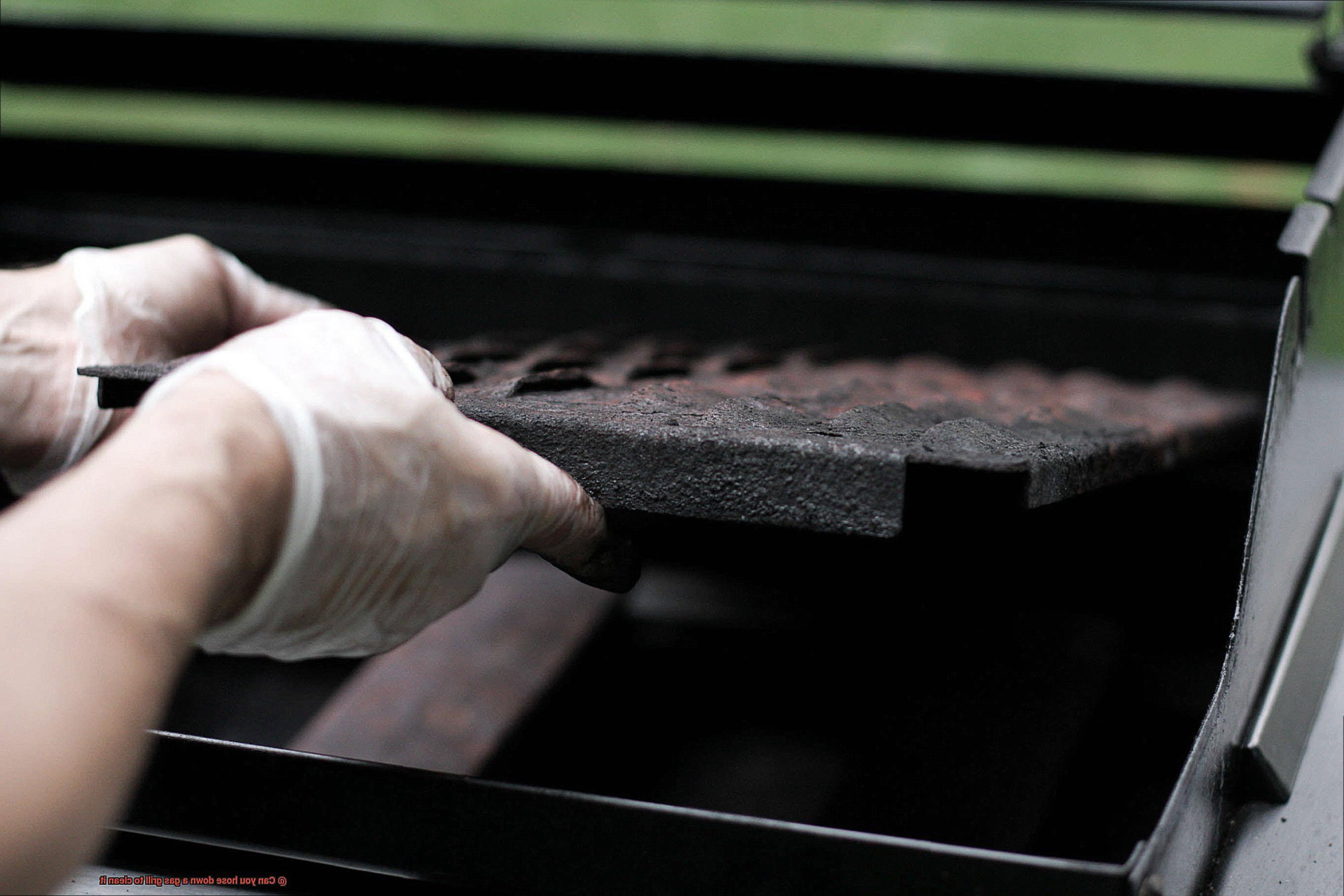
The interior of the grill should be cleaned by removing any ash or debris that may have accumulated. Use a shop vacuum or a brush to clean out the bottom of the grill. The exterior of the grill can be cleaned with warm soapy water and a sponge or cloth. Avoid using abrasive cleaners that can damage the finish.
It is important to clean the grease trap or drip pan regularly to prevent grease fires. Remove the drip pan and empty any accumulated grease, then wash it with warm soapy water. Finally, after cleaning all the components of the gas grill, reassemble them and perform a quick safety check before using the grill again. Ensure that all connections are secure and that there are no leaks in the gas supply.
Safety Considerations Before Hosing Down a Gas Grill
Gas grills are a popular choice for outdoor cooking, offering convenience and versatility. However, before hosing down a gas grill, there are several key safety considerations to keep in mind. These include turning off the gas supply, waiting for the grill to cool down, disconnecting the propane tank, removing removable parts, protecting electrical components, using appropriate cleaning solutions, being cautious of grease buildup, using gentle water pressure, protecting surrounding areas, and drying the grill thoroughly.
First and foremost, it is crucial to turn off the gas supply before starting any cleaning or maintenance tasks on your gas grill. This ensures that there is no risk of accidental gas leaks or fire hazards while cleaning the grill.
Next, it is important to allow the grill to cool down completely before you begin hosing it down. This not only prevents any burns or injuries from hot surfaces but also reduces the risk of steam and hot water splattering when you start cleaning.
If your gas grill is connected to a propane tank, make sure to disconnect it before hosing down the grill. This eliminates any chances of gas leakage during the cleaning process and ensures a safer environment.
Before hosing down the grill, it is advisable to remove the cooking grates, flavorizer bars, and any other removable parts. This allows for easier and more thorough cleaning, as well as prevents any damage to these parts from excessive water pressure.
Some gas grills may have electrical components like ignition switches or lights. It is essential to ensure that these components are protected from water exposure before hosing down the grill. If necessary, cover them with plastic bags or use waterproof tape to prevent any damage.
While hosing down a gas grill is an effective way to remove dirt and debris, using appropriate cleaning solutions can enhance the cleaning process. Avoid using harsh chemicals that can damage the grill’s surface or leave behind toxic residues. Opt for mild dish soap or specialized grill cleaners that are safe for use on gas grills.
Gas grills often accumulate grease and fat residues, which can pose a fire hazard if not cleaned properly. Before hosing down the grill, make sure to scrape off any visible grease buildup using a grill brush or scraper. This reduces the risk of grease splattering or clogging the hose during cleaning.
When hosing down a gas grill, it is important to use a gentle water pressure setting. Avoid using high-pressure jets or power washers, as they can damage the grill’s delicate components and seals. A garden hose with a spray nozzle set to a gentle mist or shower pattern is typically sufficient for cleaning purposes.
Before hosing down your gas grill, consider the surrounding environment. Ensure that nearby electrical outlets, appliances, or furniture are adequately protected from water exposure. If necessary, cover these items with waterproof materials or move them to a safe distance to prevent any damage.
After hosing down the gas grill, it is crucial to dry it thoroughly before using it again. Excess moisture can promote rusting and corrosion on metal surfaces, affecting the longevity of your grill. Use a clean cloth or allow the grill to air dry completely before reassembling and storing it properly.
Removing and Cleaning Removable Parts
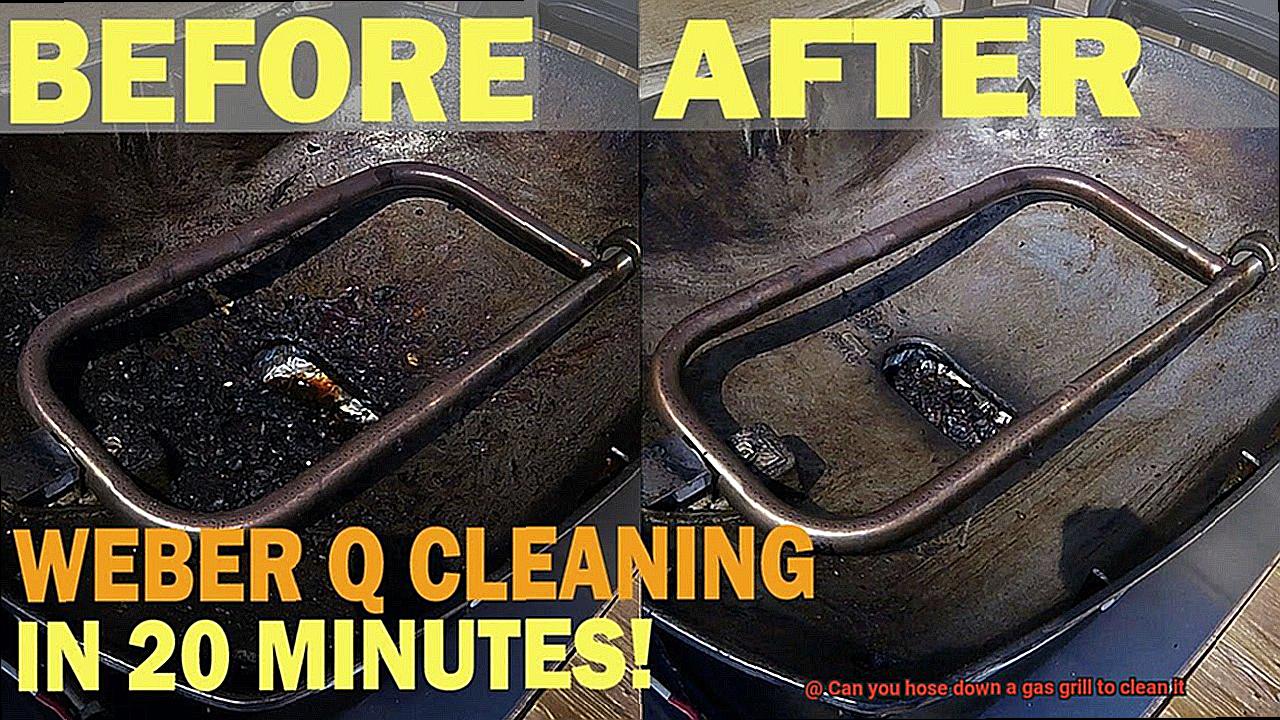
To properly clean a gas grill, it is crucial to start by removing and cleaning the removable parts. These parts include the grates, burner covers, heat plates, and grease tray. By following these steps, grill enthusiasts can maintain their grill’s performance and extend its lifespan.
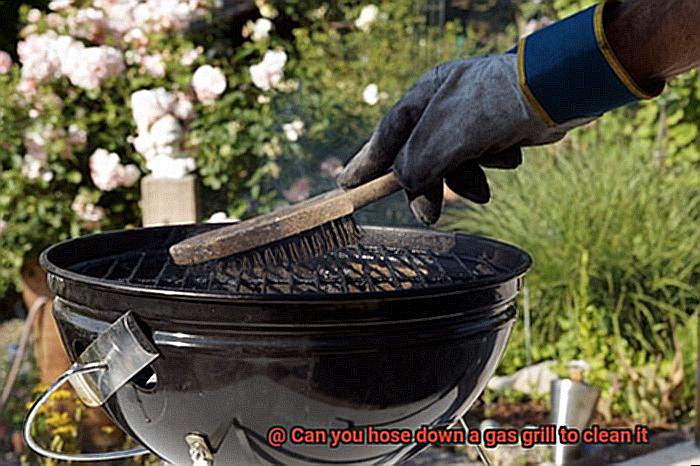
Firstly, ensure the grill is turned off and completely cooled down before attempting to remove any parts. This precautionary measure prevents accidents or burns during the cleaning process.
Begin with the grates, which are usually the first removable part. Carefully lift them off the grill, checking the manual for specific instructions on how to safely remove them. With a wire brush or grill brush, scrub away any food residue, grease, and debris that may have accumulated on both sides of the grates.
After scrubbing, rinse the grates thoroughly with water to eliminate any remaining debris or cleaning solution. It is vital to ensure that all soap or cleaning agents are rinsed off completely to avoid affecting the taste of future grilled food.
Moving on to the burner covers and heat plates, these parts can also accumulate grease and food debris over time, which can impact the grill’s performance. Use a brush or sponge with mild soap or a baking soda and water mixture to clean them. Rinse them thoroughly after cleaning to remove any residue.
Don’t forget about the grease tray. Regularly empty and clean this tray as it collects drippings from cooking. Accessible from the back or bottom of the grill, wash it with warm soapy water or put it in a dishwasher if it is dishwasher safe.
Additionally, clean the exterior of the grill by wiping it down with a damp cloth or sponge and mild soap. Avoid abrasive cleaners or scrubbers as they can damage the grill’s finish.
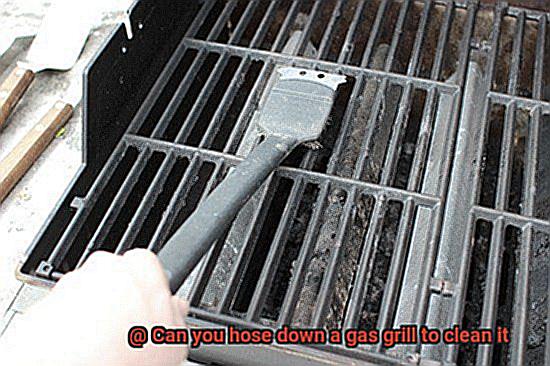
Once all the removable parts are cleaned and dried, reassemble them onto the grill. Ensure that all parts are correctly aligned and securely attached before using the grill again.
Regularly removing and cleaning the removable parts of a gas grill maintains its performance and extends its lifespan. Grease buildup can lead to flare-ups and uneven cooking, making it important to clean these parts regularly.
Consult the grill’s manual for specific instructions on how to remove and clean the removable parts, as different grills may have varying mechanisms and requirements.
Using a Garden Hose to Hose Down the Grill
Using a garden hose to hose down the grill is an important part of grilling safety. It helps to remove grease, food particles, and other debris that may have accumulated on the grill grates and surfaces. However, there are some important considerations to keep in mind when using a garden hose for this purpose.
First and foremost, it is crucial to ensure that the gas grill is completely cool before hosing it down. Attempting to clean a hot grill with water can cause damage to both the grill and the person handling the hose. Allow the grill to cool down for at least an hour after use before beginning the cleaning process.
Before turning on the hose, it is advisable to remove any removable parts of the grill, such as grates and drip pans. These components can be cleaned separately by scrubbing them with warm soapy water or using a grill brush. Once they are removed, place them in a safe location where they can be easily accessed for cleaning.
When hosing down the grill, it is important to use a medium-pressure setting on the garden hose nozzle. Using too high of a pressure can potentially damage the grill’s delicate parts, such as burners or igniters. Start by gently spraying water over the grates and other surfaces, ensuring that all areas are thoroughly wet. This will help to loosen any stuck-on food or grease.
Next, it is recommended to use a grill brush or a scrubbing pad to scrub away any stubborn residue from the grates. This can be done while simultaneously rinsing with water from the hose. Pay special attention to areas where grease tends to accumulate, such as the back of the grill or underneath the burners.
After scrubbing away any residue, continue rinsing with water until all traces of soap and debris are removed from the grill surfaces. Take care not to let water collect in any recessed areas or drip pans, as this can lead to rust or corrosion over time. Thoroughly inspect the grill to ensure that it is clean and free from any remaining grime.
Once the grill is clean, allow it to air dry completely before reassembling the removed parts. This will help prevent any moisture from causing rust or other damage. Once dry, carefully reattach the grates, drip pans, and any other removable components.
While using a garden hose to clean a gas grill can be an effective method, it may not be suitable for all types of grills. It is important to consult the manufacturer’s instructions or guidelines to ensure that hosing down the grill is an approved cleaning method. Some grills may have specific cleaning instructions that differ from this general approach.
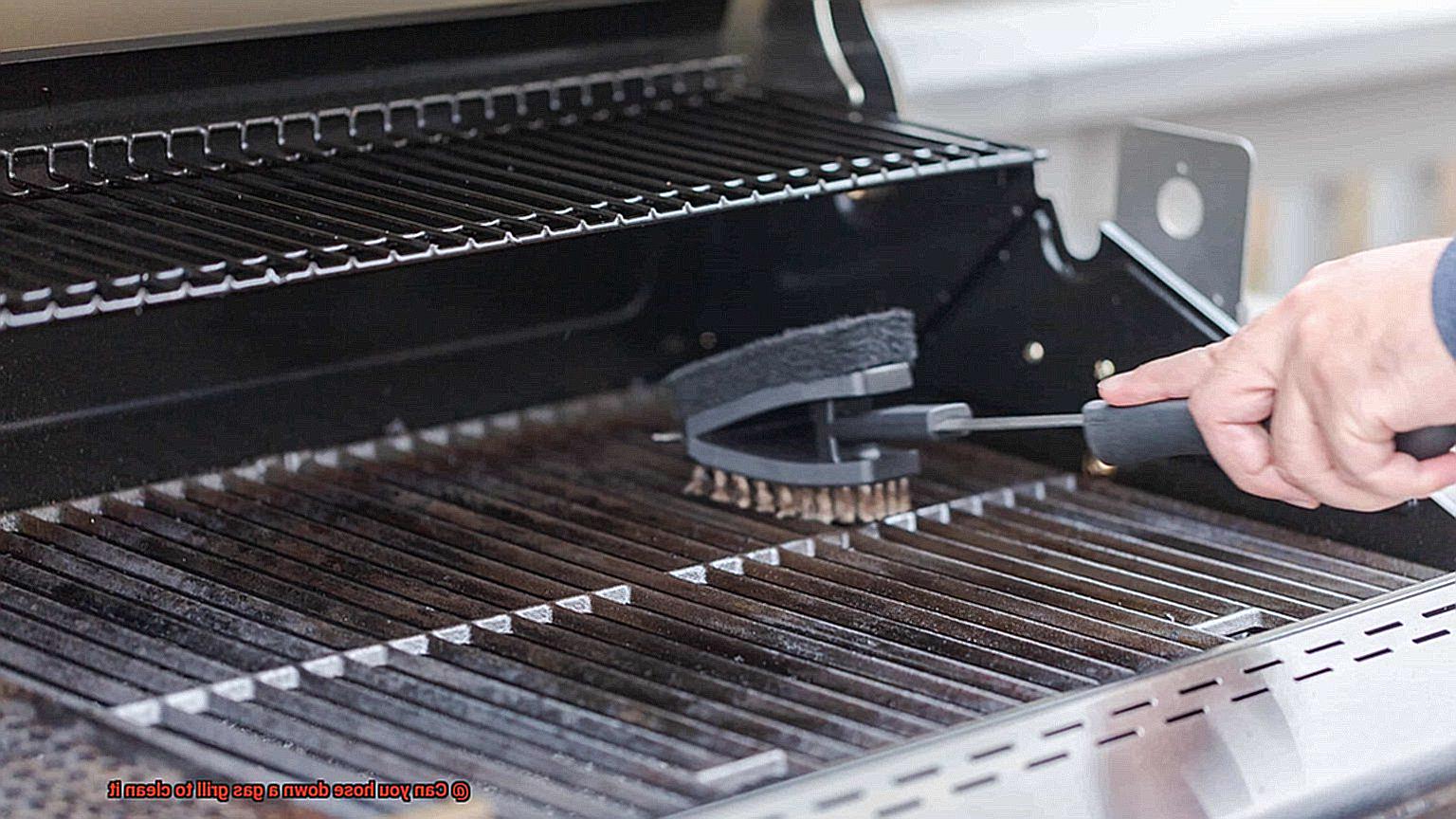
Avoiding Harmful Chemicals When Cleaning
When it comes to cleaning your gas grill, it’s crucial to steer clear of harmful chemicals that can jeopardize your health and harm the environment. Many commercial cleaning products contain toxic chemicals that can be detrimental if ingested or inhaled. These substances have the potential to cause respiratory problems, skin irritation, allergies, and other health issues. This is particularly concerning when it comes to grilling food, as these chemicals can easily come into contact with what we eat.
In addition to the health risks, using harmful chemicals when cleaning a gas grill can have a dire impact on the environment. These chemicals can contaminate water sources, inflict harm upon wildlife, and contribute to pollution. As responsible grillers, it’s of utmost importance for us to be mindful of the products we employ to clean our grills and minimize the environmental damage.
So, how can we avoid using harmful chemicals when cleaning our gas grills? The good news is that there are natural alternatives that are equally effective. Vinegar, baking soda, and lemon juice are outstanding options for removing grease and grime without posing health risks or harming the environment. These natural cleaners are readily available and can be blended together to concoct a potent cleaning solution.
To cleanse your gas grill using natural cleaners, commence by removing the grates and submerging them in a mixture of vinegar and warm water. While they soak, scrub the grill’s interior with a paste made from baking soda and water. For stubborn stains, apply some lemon juice onto a sponge and vigorously scrub away. Always remember to don gloves and eye protection for added safety.
By regularly maintaining your gas grill without resorting to harmful chemicals, you not only prolong its lifespan but also enhance the flavor of your food and prevent flare-ups. Opting for natural cleaning solutions ensures that you can grill with peace of mind, free from the risk of chemical residue contaminating your food.
Rinsing off Soap Residue with Clean Water
Picture this: the sizzle of the gas grill, the mouth-watering aroma of perfectly grilled meats and vegetables wafting through the air. There’s nothing quite like a backyard barbecue. But before you unleash your culinary skills on that grilling masterpiece, it’s important to give your grill a thorough cleaning. And here’s where rinsing off soap residue with clean water becomes absolutely essential.
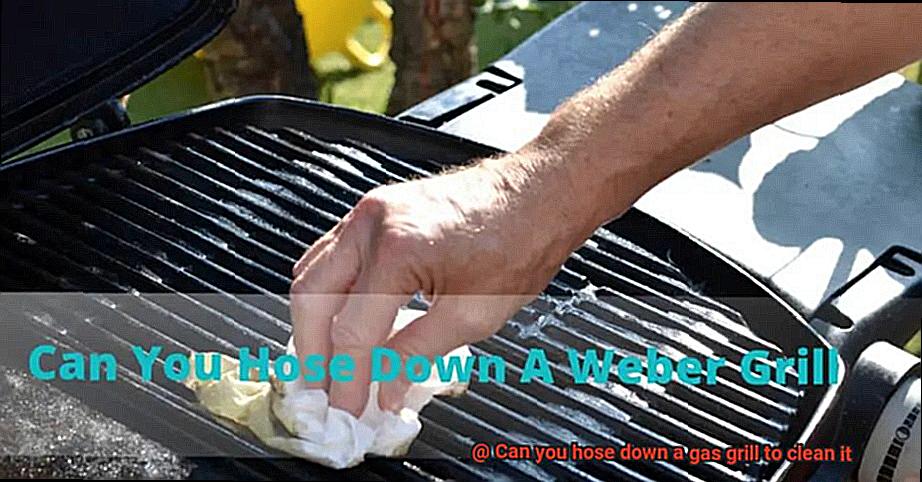
Cleaning your gas grill with soapy water is a fantastic way to cut through grease and grime, but there’s a catch – if you don’t rinse off the soap residue properly, it can stick around and cause all sorts of issues. So why is rinsing with clean water such a critical step? Let’s dive deeper into the importance:
- A Thorough Clean: Rinsing with clean water ensures that all traces of soap residue are completely removed from your grill. This means no more unsightly streaks or greasy build-up, leaving your grill sparkling clean and ready for your next culinary masterpiece.
- Health Hazards Begone: Leaving soap residues on your grill can potentially pose health hazards if consumed. Imagine taking a bite of that juicy, perfectly grilled steak only to be greeted by an unpleasant soap flavor. By rinsing off the soap residue, you eliminate this risk entirely and ensure a safe dining experience.
- Banishing Lingering Odors: Soap residues can leave behind unwelcome odors that may affect the taste of your food. Who wants their perfectly seasoned kebabs to have a hint of lavender-scented soap? Rinsing with clean water helps eliminate any lingering odors, leaving your grill smelling fresh and ready to take on any culinary challenge.
Now that you understand the importance of rinsing off soap residue, let’s talk about how to do it properly:
Gather your tools: Get a hose or a bucket filled with clean water ready for rinsing.
- Cover every inch: Gently spray or pour the water over the entire grill, ensuring you cover every nook and cranny. Pay special attention to the grates, burners, and any other surfaces that were cleaned.
- Gentle pressure is key: Be mindful of the water pressure. You want to be thorough without damaging any delicate parts of the grill. A gentle spray or pour will do the trick.
But hold your horses, grill masters. There’s one last crucial step after rinsing off that soap residue – drying your grill thoroughly. This is vital to prevent rusting or corrosion, ensuring your grill stays in top-notch condition for many more grilling adventures to come.
Cleaning the Exterior of the Grill
Cleaning the exterior of your gas grill is crucial for maintaining its appearance, functionality, and durability. Not only does regular cleaning improve the overall performance of your grill, but it also helps prevent corrosion and extends its lifespan. Follow these step-by-step instructions to safely clean the exterior of your grill and keep it in top shape.
- Safety first: Before you begin cleaning, ensure that your grill is turned off and disconnected from the gas source. This precautionary measure will prevent any accidents or mishaps.
- Remove loose debris: Start by using a grill brush or a soft cloth to remove any loose debris or food residue from the exterior of the grill. Take care to be gentle so as not to scratch or damage the surface.
- Identify the material: Gas grills are commonly made of stainless steel, cast iron, or porcelain enamel. Each material requires specific cleaning methods. Identify the material of your grill and follow the appropriate cleaning instructions.
- Cleaning stainless steel: For stainless steel grills, mild soap and water are usually sufficient. Use a sponge or a soft cloth to gently scrub away dirt or stains. Rinse with clean water and dry thoroughly.
- Specialized cleaning for cast iron: If your grill has cast iron grates or components, they may require more specialized cleaning methods. Consult your grill’s manual or manufacturer’s instructions for specific recommendations.
- Hose down with caution: Stubborn dirt or grease buildup on the exterior can be effectively removed by hosing down the grill. However, take precautions to prevent water from entering any electrical components or gas valves.
- Use a garden hose with a spray nozzle attachment: Attach a spray nozzle to your garden hose to control the water flow and pressure. Avoid using high-pressure washers as they can damage the grill’s surface.
- Start from top to bottom: Begin hosing down the grill from top to bottom, using sweeping motions to remove dirt and stains. Pay special attention to areas with visible buildup.
- Dry thoroughly: After hosing down, dry the grill’s exterior thoroughly using a clean cloth or by allowing it to air dry. This step is crucial in preventing water spots and corrosion.
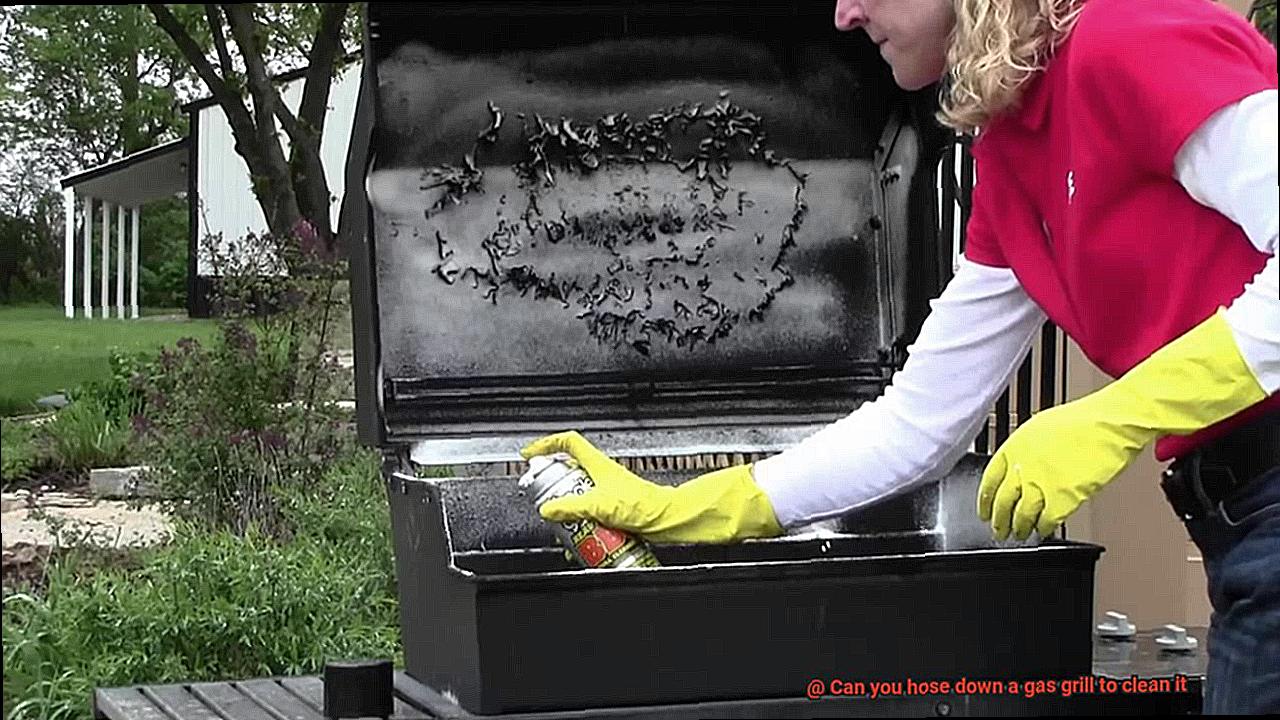
Drying and Reassembling the Grill
You’ve given your grill a good hose-down, but now it’s time to take the next steps to ensure it’s dry and ready for action. Drying and reassembling your grill properly is crucial to prevent rust and damage, and it’s easier than you might think. Get ready to master the art of grill maintenance with this step-by-step guide:
- Wipe down the exterior and interior: Grab a clean, dry cloth and give your grill a thorough wipe-down. This will eliminate any lingering water droplets that could cause trouble later on.
- Let it air dry: Find a well-ventilated area where you can leave your grill for a few hours. Allowing it to bask in the open air will give any remaining moisture a chance to evaporate. For an extra boost, position the grill in direct sunlight, harnessing the power of the sun to speed up the drying process.
- Dry removable parts separately: If your grill has grates or burner covers that can be removed, take them off and dry them separately. Using a dry cloth, give them a wipe-down, and then let them air dry completely.
- Reassemble according to the manufacturer’s instructions: Once everything is dry, it’s time to put your grill back together. Follow the manufacturer’s instructions carefully to ensure that all parts are positioned correctly. This step is vital for proper functioning and safety.
- Inspect connections and check for damage: Before firing up your grill again, take a moment to inspect all connections and make sure they are secure. Look out for any signs of wear or damage that may require attention before using the grill.
- Test run: Finally, give your grill a quick test run by turning on the burners and letting them heat up for a few minutes. This will burn off any remaining moisture and give you peace of mind that everything is in working order.
74dMn_KesQk” >
Conclusion
In conclusion, it is safe and effective to hose down a gas grill to clean it.
The powerful stream of water will remove grease, grime, and food residue from the grates and surfaces. Just make sure to disconnect the gas supply and let the grill cool down before starting the cleaning process.
Remember to use a gentle pressure setting on your hose nozzle to avoid damaging any delicate parts. Once you’re done hosing down, give the grill a thorough drying with a clean cloth or allow it to air dry completely before using it again.
By regularly hosing down your gas grill, you’ll keep it in top condition and ensure delicious and safe barbecues every time.

